Learning to play the guitar opens up a world of musical possibilities, but improper technique can lead to frustration and even injury. One of the most fundamental aspects of guitar playing, often overlooked by beginners, is Guitar Hand Position. Correct hand positioning is crucial for producing clear, buzz-free notes, playing comfortably for extended periods, and preventing pain or long-term injuries. This guide will walk you through the essential elements of proper guitar hand position, ensuring you start your musical journey on the right note.
1. Optimal Finger Placement for Clean Notes
When fretting a note, your finger placement on the fretboard is paramount. The ideal spot to place your finger is as close as possible to the fret wire, without being directly on top of it. Positioning your finger near the fret maximizes leverage and ensures a clean break angle for the string, resulting in a clear and resonant tone. Conversely, placing your finger too far behind the fret requires significantly more pressure to fret the note properly, often leading to buzzing or muted sounds. It also increases unnecessary strain on your hand. Remember, less effort equals cleaner sound and happier hands! Aim for the sweet spot just behind the fret.
This finger position, placed close to the fret, allows for clean notes with minimal effort, crucial for efficient guitar fretting.
 Incorrect finger placement too far from the fret requiring excessive pressure and potentially causing buzzing
Incorrect finger placement too far from the fret requiring excessive pressure and potentially causing buzzing
This finger position, too far from the fret, demands excessive strength and may still produce a buzzing or unclear sound, illustrating poor guitar hand technique.
2. Discovering Your Fingertip Sweet Spot for Guitar Fretting
As you practice fretting notes, you’ll begin to notice a “sweet spot” on each of your fingertips. This is the area that, when applied to the string, feels most efficient and natural for producing a clear sound. It’s not necessarily the very tip of your finger, but often slightly below it. Identifying these sweet spots early on is key to developing efficient fretting technique. Being mindful of landing on these areas during practice sessions will improve your accuracy and reduce unnecessary effort.
Keep in mind that the size of this sweet spot varies with each finger. Your pinky finger, being smaller, naturally has a smaller sweet spot. This is a primary reason why many beginner guitarists find using their pinky finger for fretting more challenging. Focused practice and awareness of this sweet spot will help overcome this common hurdle.
3. Thumb Position: The Anchor for Proper Guitar Hand Posture
A common complaint among new guitar players is thumb soreness. This discomfort can extend beyond the thumb itself, affecting tendons in the hand, wrist, and even arm. Ignoring this issue can potentially lead to a painful condition known as De Quervain’s Syndrome, or “Gamer’s Thumb.” Paying attention to your thumb position and hand comfort while playing is crucial for preventing such problems.
The correct thumb position is generally on the back of the guitar neck, roughly opposite your index or middle finger. Ideally, your thumb should point upwards, almost perpendicular to the neck. Avoid stretching your thumb out parallel to the neck, as this creates unnecessary tension and strain. Think of your thumb as a gentle anchor, providing support without excessive pressure.
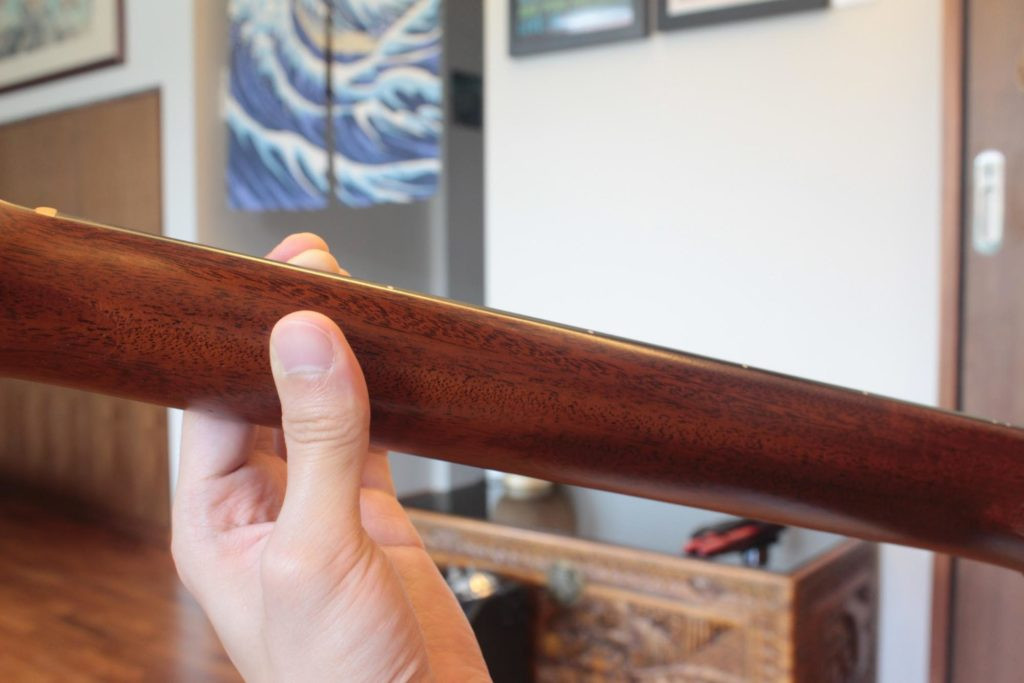 Ideal thumb position on the back of the guitar neck promoting relaxed hand posture
Ideal thumb position on the back of the guitar neck promoting relaxed hand posture
This image demonstrates the ideal thumb position on the guitar neck, positioned behind the fingers to support a relaxed and efficient guitar hand position.
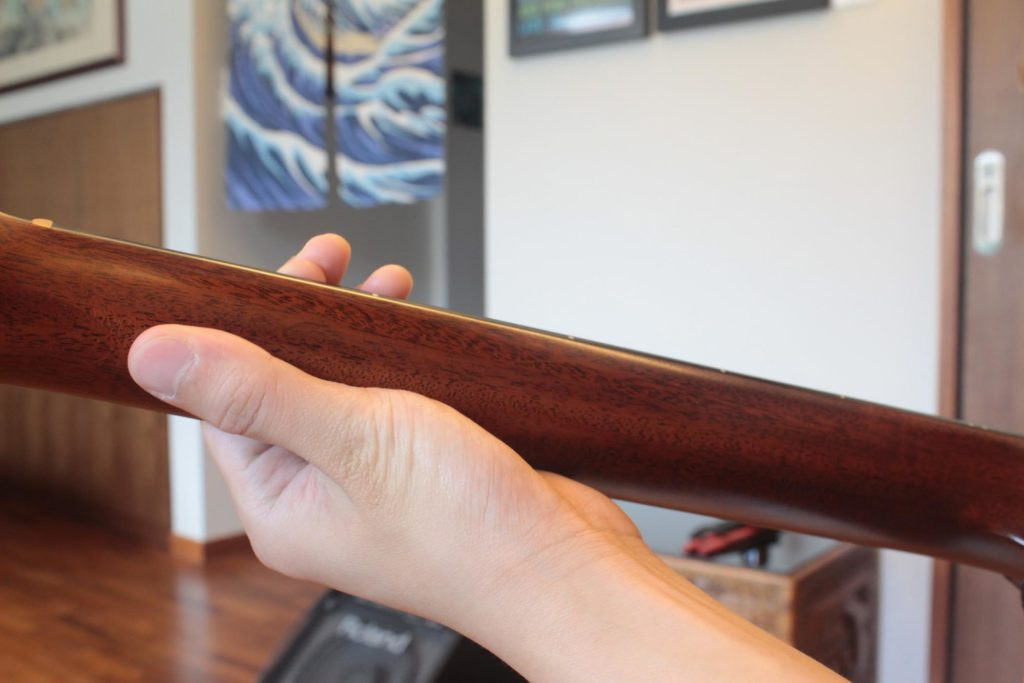 Thumb position parallel to the guitar neck, potentially causing tension and discomfort during playing
Thumb position parallel to the guitar neck, potentially causing tension and discomfort during playing
This image shows a thumb position that is too high and parallel to the neck, which can lead to unnecessary tension and strain in the hand and wrist while playing guitar.
While these are general guidelines, there are exceptions, especially when using your thumb to fret bass notes. However, the overarching principle remains: your thumb should rarely experience tension. Comfort and the absence of tightness are your best indicators of proper thumb placement.
4. Finger Curvature: Avoiding Muted Strings When Fretting Chords
When playing chords, especially as a beginner, you’ll quickly realize the importance of finger curvature. Curving your fingers properly is essential to avoid accidentally muting adjacent strings. A classic example of this challenge is the D major chord. Beginners often find their ring finger unintentionally touching and muting the high E string.
 Diagram of a D major chord illustrating finger placement for guitar beginners
Diagram of a D major chord illustrating finger placement for guitar beginners
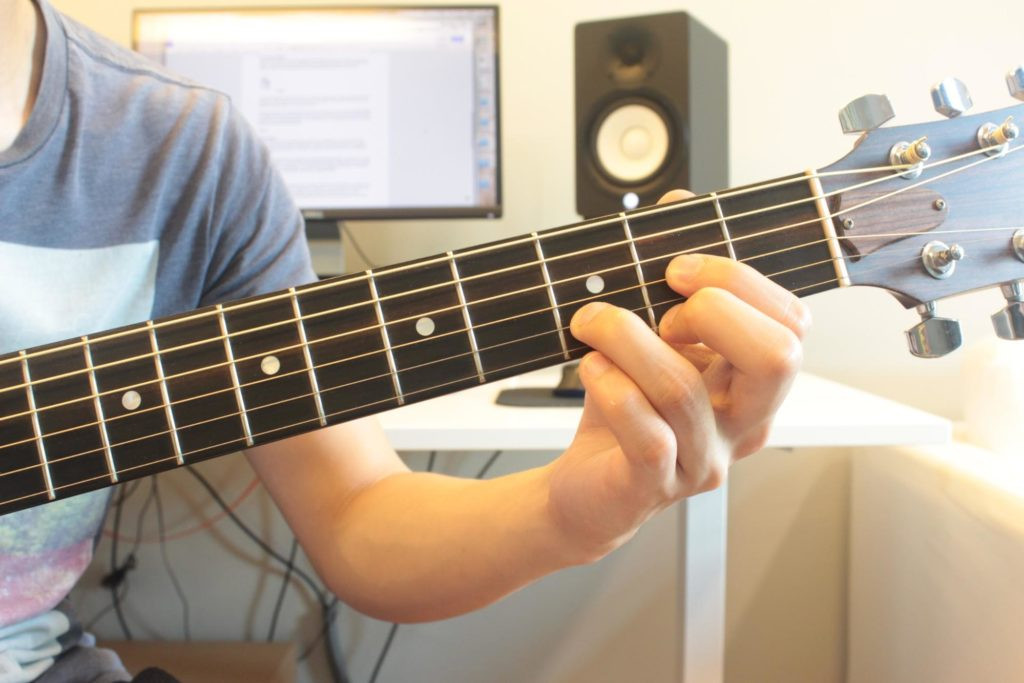 Proper finger curvature demonstrated for playing chords without muting adjacent strings
Proper finger curvature demonstrated for playing chords without muting adjacent strings
This image highlights the necessary finger curvature when fretting guitar chords to avoid muting adjacent strings, a key aspect of correct guitar hand positioning.
The solution is often simply increasing the bend in your ring finger at the first joint. This adjustment creates the necessary space for the high E string to ring clearly.
A helpful exercise to visualize proper finger curvature is to make a fist with your right hand and then wrap your left hand around it. This provides a tangible representation of the approximate curvature your fretting fingers should adopt. Observe how the first joints of your left-hand fingers align roughly over the knuckles of your right hand.
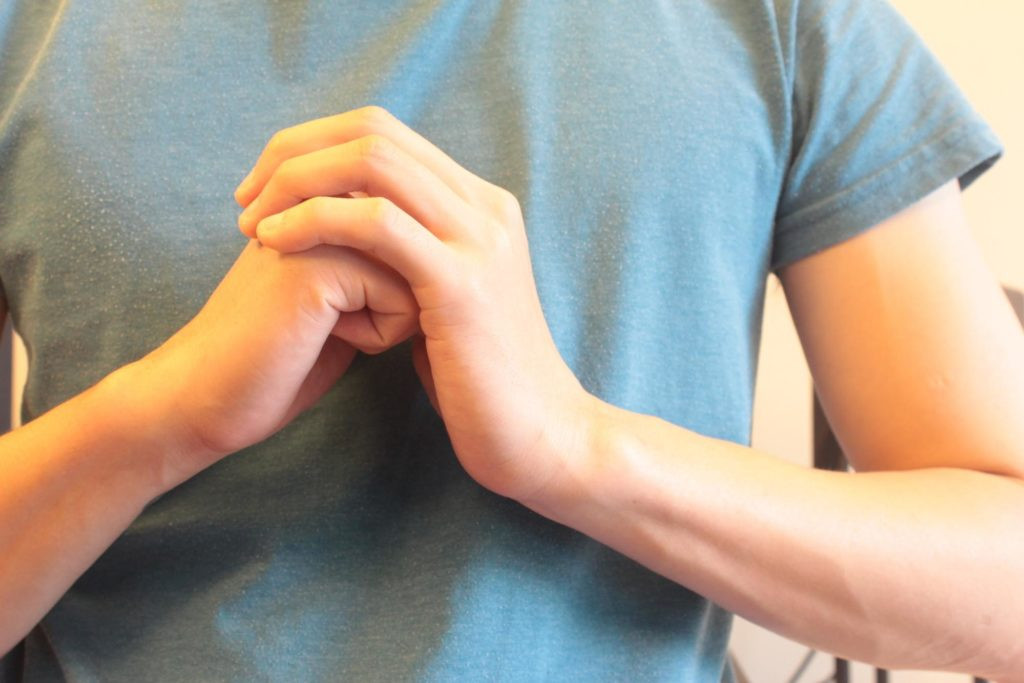 Using a fist to demonstrate proper finger curvature for guitar fretting technique
Using a fist to demonstrate proper finger curvature for guitar fretting technique
This image uses a fist analogy to visually demonstrate the ideal curvature of the fingers when fretting notes on the guitar, aiding in understanding correct hand position.
5. Wrist Position: Maintaining Relaxation and Preventing Strain
Wrist pain is another frequent complaint from beginner guitarists and a serious issue to address. Sustained improper wrist positioning can potentially lead to carpal tunnel syndrome, a painful and persistent condition. Maintaining a relaxed wrist position for the majority of your playing time is crucial for prevention.
Your wrist should not be excessively bent forwards or backwards. In most playing situations, a slight forward bend is natural and comfortable. It should feel like your wrist is in a neutral, resting state rather than an extended or strained position.
As long as your wrist feels relaxed while playing and isn’t sore afterward, you’re likely in good shape. However, if you experience wrist pain during or after playing, consciously focus on your wrist placement. Simply becoming aware of tension in your wrist is often enough to correct the issue.
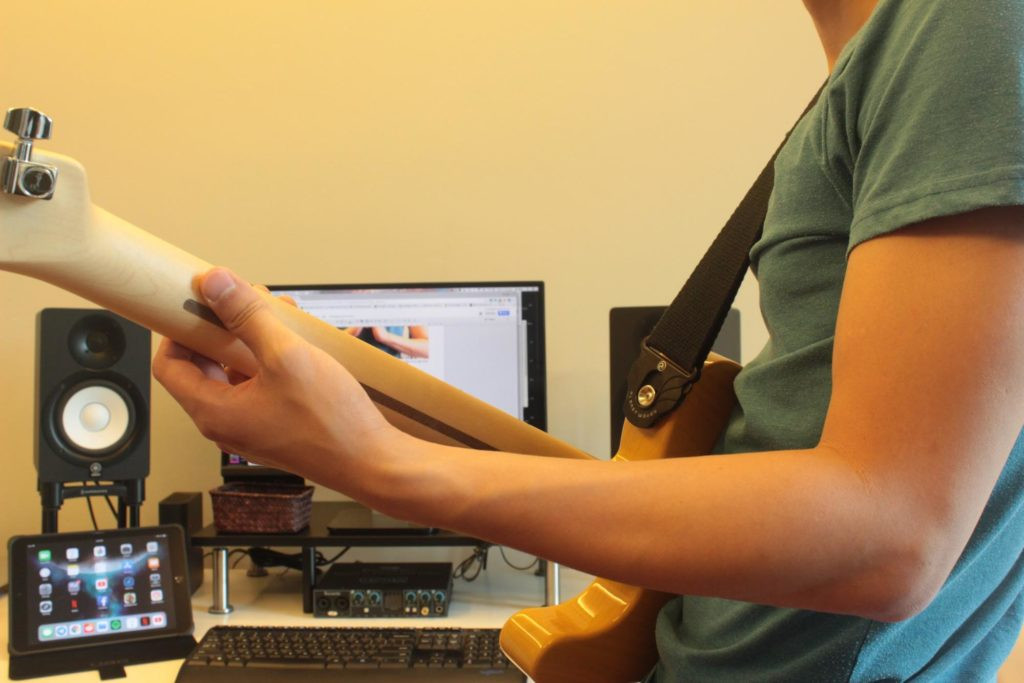 Natural and relaxed wrist position essential for comfortable and injury-free guitar playing
Natural and relaxed wrist position essential for comfortable and injury-free guitar playing
This image showcases a natural and relaxed wrist position, crucial for maintaining comfort and preventing injuries while playing guitar for extended periods.
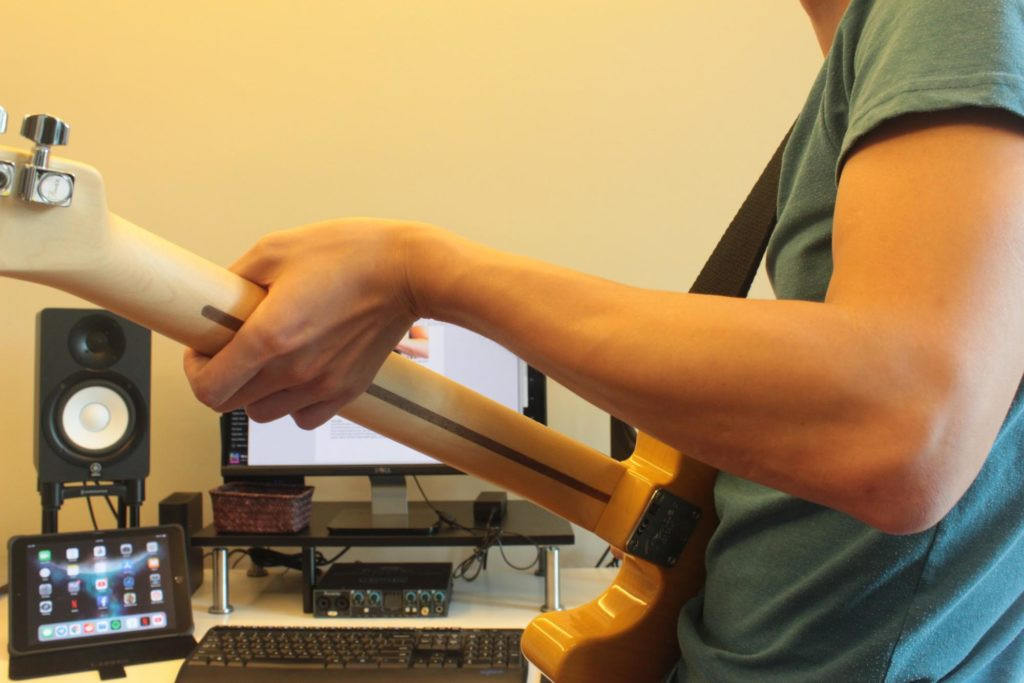 Overextended wrist position that can lead to strain and discomfort during guitar playing
Overextended wrist position that can lead to strain and discomfort during guitar playing
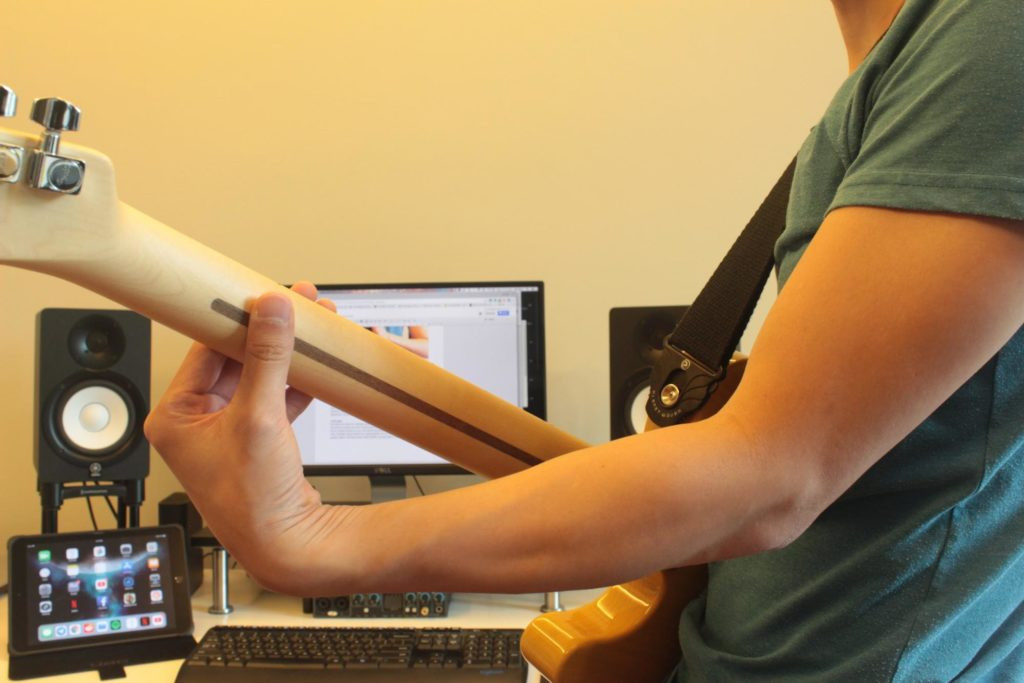 Another example of an overextended wrist position to be minimized for healthy guitar playing habits
Another example of an overextended wrist position to be minimized for healthy guitar playing habits
These images illustrate overextended wrist positions that should be avoided as much as possible to prevent strain and potential injuries, emphasizing the importance of proper guitar ergonomics.
Time to Play!
Mastering proper fretting technique and guitar hand position is one of the most accessible aspects of learning guitar. Most beginners can grasp these fundamental techniques within a short period. The key takeaway is to remain mindful of tension in your hands and wrists to prevent potential long-term injuries. While it might seem surprising that guitar playing can lead to injuries, it’s more common than many realize. So, prioritize healthy hand posture, practice mindfully, and enjoy your guitar journey!
